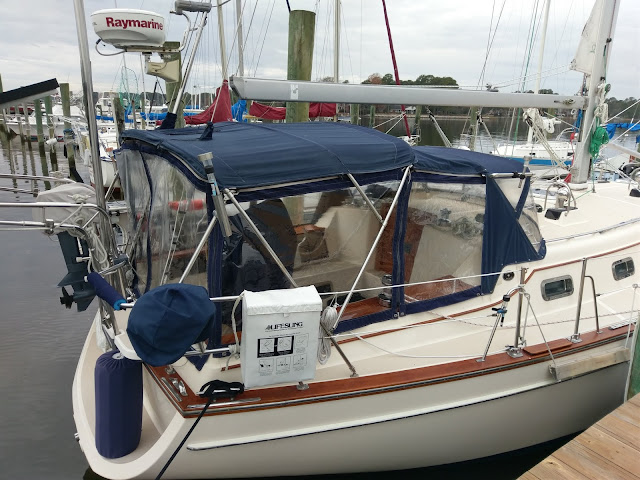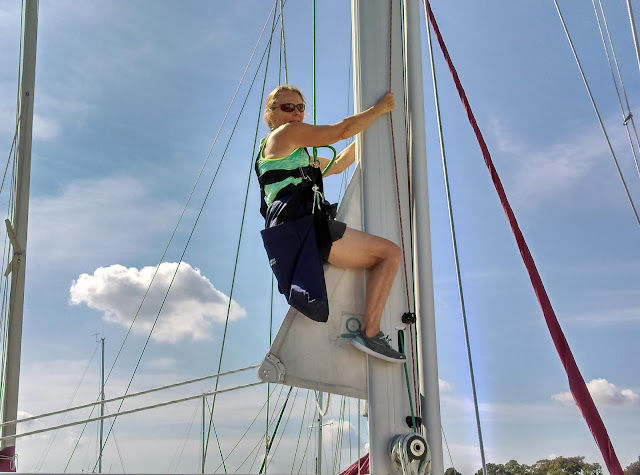Hurricane Florence provided a good opportunity to assess how ready we are to anchor out on the boat for extended periods and, how reliable the boat systems are going to be for winter cruising.
Our marina (up on the right in the photo) makes all the heavier boats leave the marina for named storms as their pylons are not that firmly planted and the easterly winds/seas come straight up the creek through the marina. Besides, our slip is pretty narrow and not the place one would want to be in significant waves so we choose to always leave and anchor out for serious blows. We anchor just up the creek in a fairly protected spot.
Normally for expected hurricane conditions I would put out two anchor lines - our Bruce 44 on 200fteet of chain and our Fortress 37 on 200+ft of 3/4in nylon line. Neither of these anchors have ever dragged or plowed through the mud bottom of Chisman Creek (unlike a CQR we used a long time ago which plowed right through the mud.)
For Florence, though, the forecast was only for 25-35kt winds at our location, so I went with our single Bruce44 on chain. I use a 1/2in twisted 3 strand line for a snubber with a heavy duty rubber snubber attached to the line as seen above. I tie the line onto the chain with a simple rolling hitch. I have never had a problem with this hitch.
Florence turned out to be a non-event for the Hampton Roads area. We never saw any sustained winds over 25kts and only a few gusts higher. There were several showers, but not the heavy rains that the Carolinas received. The winds did stay at 25kts for several days, so we sat around from Wednesday to the following Monday before returning to the marina. That gave us 6 days to check out all the systems on the boat.
Most importantly, 6 days gave us time to train Rivah to do her potty work on the bow. She held out for 3 days, but ultimately had to go. With lots of rewards and treats, she pretty much had it down by day 6 and even "asked" to go forward a couple times and did her business. She should be ready to go south for the winter with us now and not be discomforted when she cant go ashore for several days.
We had very few problems over the 6 days. One issue though was the pump gasket on the head had dried out over the past two years of storage so, this was a good opportunity to install the rebuild kit I had onboard. With new rubber gaskets properly lubricated the head worked like new.
We also were able to troubleshoot the wind generator which wasnt working properly. I found a ground wire that I had not connected when replacing the house battery bank. The wire was hidden behind the batteries and other wires so we hadn't seen it before. Not having the wind generator, which would have provided us lots of charging in the 20kt winds, and no sun for the 6 days (so no solar charging), gave us the opportunity to test our Honda generator and boat battery charger which performed perfectly. We now have the wind generator working properly so are set for cloudy days in the future.

The most uncomfortable aspect of Florence was 5 days of 100% humidity and mid-80s temperatures which left us warm and sweaty each day. We have a cockpit shower which worked properly but requires us to run the boat engine to heat our hot water. Our normal shower system which requires no boat power is our solar shower which can heat the water scalding hot in bright sunlight. We showered in the cockpit each evening before heading to bed. (We do have a shower below but that requires a significant cleaning/wipe down effort after each shower. Much more convenient to shower in the cockpit.)
Nothing like a morning breakfast of eggs and toast and tea. The stove and refrigerator worked flawlessly for our 6 days. Looks like we are ready to head south.



























































